Burial Sites
Ireland & Scotland
Alfonso Pacitti
updated April 2024
Out of the 442 known Italian casualties, it has only been possible to identify the final resting
places of just twenty-two individuals. Their graves can be found in small churchyards around the west
coast of Ireland from County Mayo in the Irish Republic to Rathlin Island in Northern Ireland and
then northwards to Scotland through the Inner Hebrides as far as the islands of Barra and South Uist
and finally on the west coast of Scotland in South Ayrshire. After
the war a number of bodies were returned to their country of birth and others were re-interred in the
communities in which they had made their homes.
This
AS Burial Spreadsheet,
recently compiled by Alan Davis
and Terri Colpi, provides summary detail of the twenty-two men whose final resting place is known.
So why were so few victims recovered and identified?
The Arandora Star went down comparatively close to land (75 miles north west of Ireland). With
the prevailing westerly winds as well as the Gulf Stream, one would have expected that the
bodies of many more of the casualties would have been found. Certainly some were recovered by
the Canadian destroyer HMCS St Laurent during the rescue mission, however many of the
survivors reported that considerable numbers stayed aboard the stricken vessel.
They were either unsure of what to do or afraid of jumping into the water. Many were from the
mountainous regions of their homeland and had little or no experience of boats or the sea and
almost certainly therefore, could not swim. They majority were older men and even those who did
attempt to save themselves would not have lasted long in the cold waters of the Atlantic, even in
summer. The sea survival time may have been as little as ten minutes.
There are 38 known sites in the west of Scotland and Northern Ireland where bodies of victims
from the Arandora Star were buried. The identity of most of these victims is not known.
Ireland
In late July and throughout August 1940, in the weeks after the sinking, strong
north westerly gales carried many
of the bodies towards the shores of Ireland. In Donegal, the most northerly county, the local papers
reported that 33 bodies were washed ashore in one week. Almost 300 km south-west in County Mayo,
the Western People Newspaper for 10 August 1940 carried the headline - '100 Dead Bodies Floating
in sea off Inniskea'. However the seas were so rough that they could not be recovered.
The newspapers reported each grim discovery, stating that the unknown victims had been buried
alongside the soldiers. The Army personnel had identity discs and pay-books, but very few
civilians, would have carried any papers or documentation which, even if they had survived four
weeks immersion in salt water, could have been used to confirm an identity. The soldiers were
named in the burial registers, the unknowns were not and often the shallow depressions between
the Army headstones were the graves of the unknowns.
All along this wild and hazardous coastline and despite the treacherous conditions, local people
took considerable risks to recover the bodies, which were treated with great sympathy and
reverence. There were so many bodies, it was reported, that during the second week of August, a
party of four Italians including a professor of Italian from Trinity College Dublin, visited the west
coast of Ireland on behalf of the Italian Consul to see if they could identify some of the casualties.
Sadly they were unable to do so.
The recovery of so many bodies in early August created problems for the local Health Boards in
what were very poor and isolated regions. Local newspapers such as the Western People and the
Donegal Vindicator reported that the Health Boards were finding great difficulty in meeting the
costs of setting up formal inquests and providing coffins and funerals for the deceased, let alone
headstones.
In those days the west coast was a very isolated Irish speaking area reached by gravel roads
normally used by donkey carts. Only a few professional people like doctors had cars, and petrol
was rationed. Very few people had telephones. So it was difficult to assemble the coroner, his
staff and a twelve-man jury for so many inquests along 200 miles of this wild coastline. As the
scale of the disaster unfolded, it was agreed that local doctors could authorise the interment of
war victims and thus most of the deaths were not recorded.
Soon, the councils had to reopen old graveyards, some dating from the Famine almost 100 years
before. Donegal Board of Health was told that 33 bodies had been washed ashore during the
previous week and that funeral expenses had been paid by board officers out of their own
pockets.
Unidentified bodies were buried in cemeteries close to where they were found, in unmarked and
unrecorded graves, in the Poor Ground - the part of the cemetery set aside for those who could
not afford to buy a plot.
In County Mayo, there was one body for every kilometre along the Erris coastline west of
Belmullet and the Board of Health became concerned at the cost of so many funerals, with coffins
costing £2.10 shillings each. That's around £360 in today's money and these were some of the poorest
areas in Ireland.
On Rathlin, a 1940 Coastguard record stated that on August 10 two bodies had been found near
the West Light. One had a document in the name of Capella, the other had no identification
and they were buried together. The previous day, two Merchant Navy seamen were buried in Bonamargy
cemetery, Ballycastle. A few days later a lifeboat from the Arandora Star was towed into Rathlin
Harbour.
Throughout August 1940, 213 bodies were washed up on the Irish coast, of which 35 were from
Arandora Star and a further 92 unidentified, also most probably from the Arandora Star.
This tragic outcome is perhaps best summed up in the words of South Donegal coroner Dr John
O' Sullivan as reported in the Donegal Democrat of 17 August 1940. Returning verdicts of death
by drowning on two unidentified bodies washed ashore locally on 10 August he said:
"Like many others, these men met cruel deaths and it is possible that their dear ones will never
learn the facts of their fate. I am sure we shall all breathe a prayer for the happy repose of their
souls and ask the Almighty to bring comfort to the hearts of their grief stricken relatives”.
However, for a very small number of families, this was not the case. There are dozens of Italians
in unmarked graves in 29 cemeteries around the north-west coast of Ireland, some
beside the British soldiers who had been their guards. These cemeteries are located
in the following locations:
- County Antrim (NI): Rathlin, Bonomarghy
- County Donegal: Tory Island, Carndonagh, Culdaff, Clonmany, Faughn, Magheragallon, Kilclooney, Carn, Ardara, Kilcar, Killybegs, Killaghtee, Frosses, Bundoran
- County Sligo: Ahamlish, Karraglhan, Dromore West, Easkey
- County Mayo: Ballycastle, Kilgalligan, Terrmoncaragh, Kilcommon Erris, Fallmore
Details of the fourteen known and identified casualties buried in Ireland are as follows:
1. Marco Baccanello
Born 3 April 1888 at Venezia, Marco moved to London and became Head Waiter at the Savoy Hotel
London. Unknown to his family his body had washed ashore at Fanad Head, Co Donegal and buried,
at Kerrykeel Burial Ground.
Marco was identified many years later around 2012 when researchers
found details of his internment in the Irish Archives at Dublin. Amongst the possessions
of an unidentified body was a cashed cheque for £14,500 made out to Ugo Ciolli, dated 1935
and signed by an 'M Bacconello'. This item allowed the researchers to identify the man as
Marco Baccanello. Today's value of this amount of money is approximately £750,000.
His family, when contacted, could add no further information concerning the cheque.
2. Cesare Camozzi
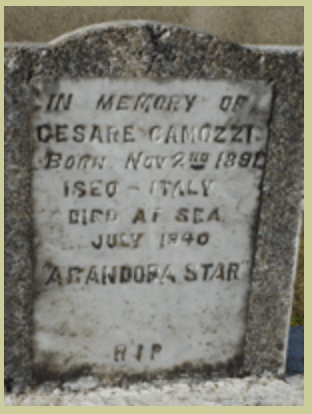
Cesare was born 2 November 1891 at Iseo, Brescia and his remains are buried in Carndonagh Cemetery,
near Malin Head, County Donegal.
He emigrated to Manchester and opened the Monogram Cafe in the city. Cesare was identified
by a letter from his wife found on his body. It was addressed to him at his Scottish
Internment Camp.
The police officer who identified the body had
the painful task of phoning Cesare’s wife Minnie in Manchester to inform her of her loss. Today his
grave is marked by a fine headstone paid for by local subscription.
(photo courtesy of Michael McRitchie)
3. Giuseppe Capella
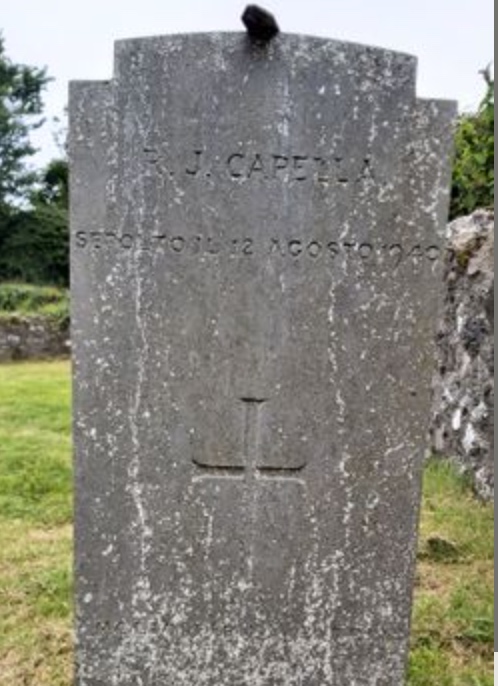
Giuseppe was born 13 April 1885 at Borgo Val di Taro (Borgotaro), Parma and he was buried in
St. Thomas Church of Ireland Churchyard, Rathlin
Island, Co. Antrim on 12 August 1940.
Giuseppe had been a waiter at the Savoy Hotel London.
A Coastguard report of 1940 notes that two bodies were found on the shore at the west end of Rathlin
Island on the same day.
Both were Italians, however, only Giuseppe could be identified from documents found on
him. They were buried alongside one another in St Thomas' Churchyard.
The grave of Giuseppe Capella is marked by this headstone.
4 Leonello Corrieri
Leonello was born 16 October 1888 at Albiano, Barga and emigrated to Liverpool where he
opened a fish and chip shop at Wallasey.
He was identified by this letter from his daughter Yolanda, found on his body.
"Dear Daddy, I am so happy to get your card this morning, just how happy you will never know. Are you
keeping well? If there is anything you want just let me know and I will send it off at once.
The weather being so nice is of course good for business. I am managing quite well, so don't worry
about me. Mummy is keeping quite well and will write you a long letter tomorrow. Yolanda"
Leonello is buried at Magheragallon Cemetery, Co Donegal.
5. Giovanni Ferdenzi
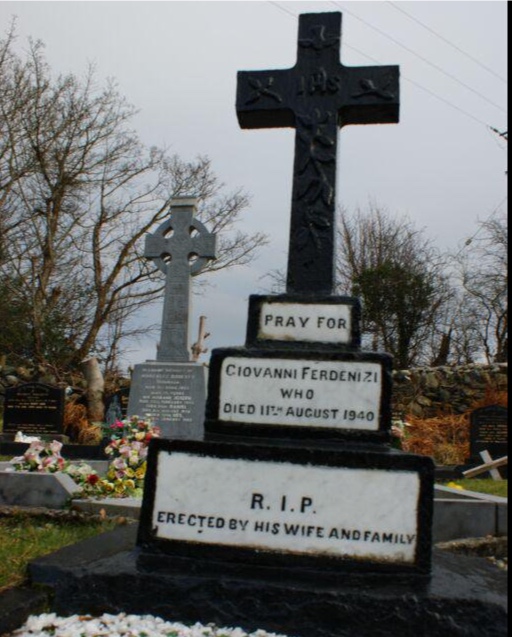
Giovanni was born 15 June 1879 at Castelleto, near Bardi and he was buried in Clonmany Cemetery, Co.
Donegal on 11 August 1940.
Giovanni ran a business delivering ice to local cafés and restaurants in
London.
This striking memorial cross, erected by his wife and family, marks his grave.
6. Matteo Fossaluzza
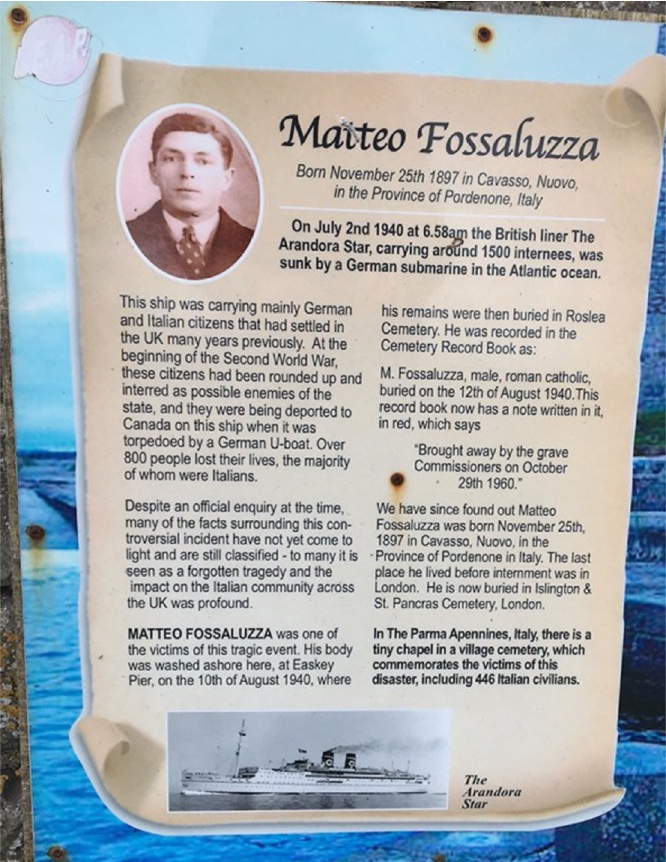
Matteo was born 25 November 1897 at Cavasso, Pordenone and buried in Easkey Cemetery, Co. Sligo.
His body, together with another found on 10 August 1940, were buried in the same cemetery.
The Western People reported that this second victim, aged about 45, had a badge with
'Associazione Nazionale Combattenti' on the front and
'L. Fassino, Corso Vittorio n. 99' on the
reverse. The second body was never identified.
Matteo's body was subsequently transferred to Islington & St. Pancras Cemetery, London
by relatives after the war.
7. Ettore Gianotti
Ettore was born 20 May 1910 at Camporgiano, Lucca and he emigrated to London
with his parents. According to the BT334 Register, his body
was washed ashore at Ballyhooriskey, Kerrykeel, Co. Donegal on 10 August 1940.
He is buried at Kerrykeel Burial Ground.
Ettore was employed in the family restaurant business in London.
His father, Alfredo, also perished on the Arandora Star
8. Luigi Giovanelli
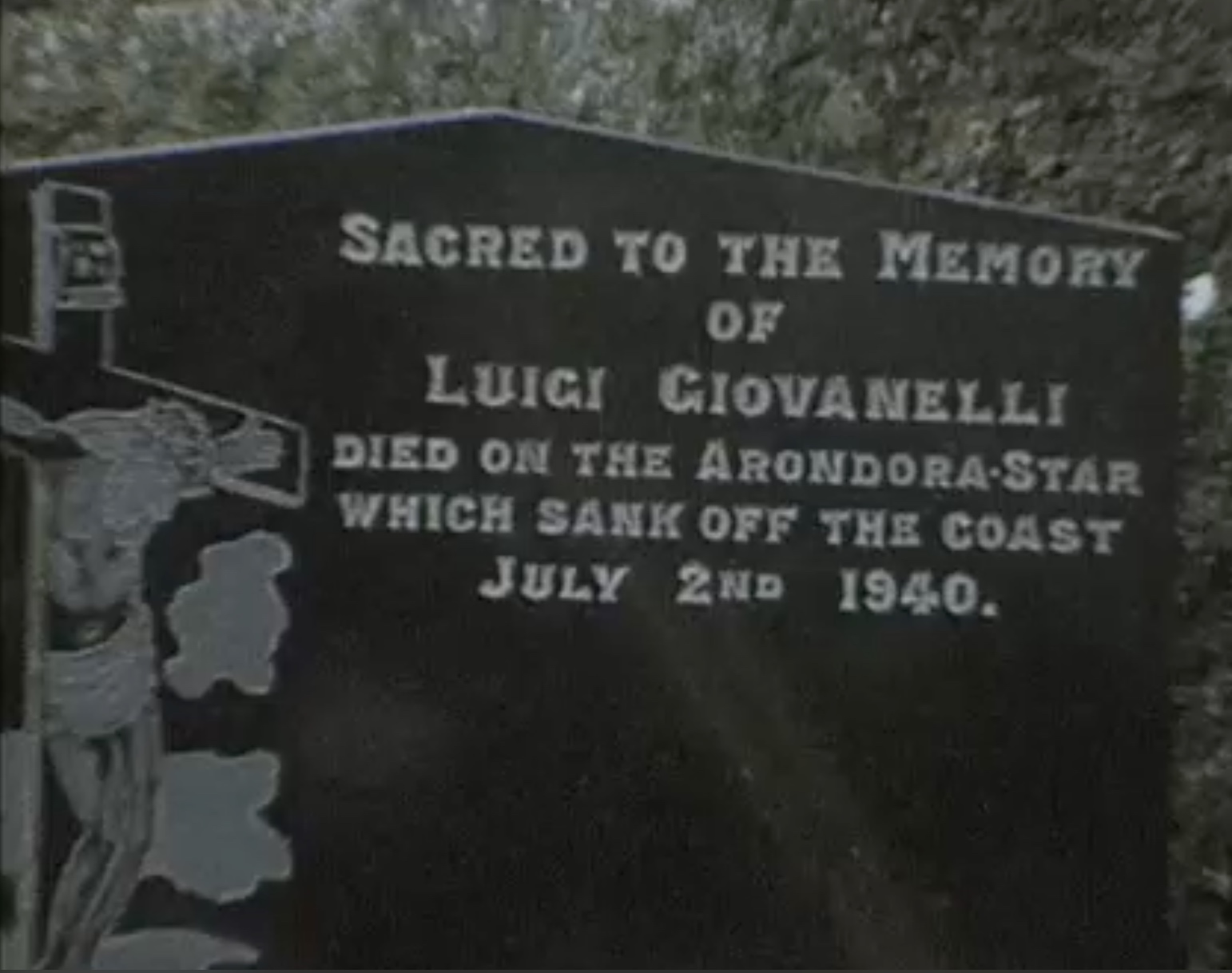
Luigi was born 24 April 1890 at Bardi, Parma and this headstone was erected to mark his death
at the Foreigner’s Graveyard on Tory Island.
Luigi's occupation was 'Glass Blower'.
He was buried at Tory Island and subsequently Luigi's body was re-interred
by his family at Islington & St Pancras Cemetery, London
9. Giovanni Marenghi
Giovanni was born on 23 April 1897 at Bardi, Parma and emigrated to South Wales.
His body was washed ashore on the remote Erris peninsula in County Mayo on 30 July 1940.
Giovanni was identified by a membership card for Pontypridd Bowling Club
and a Food Ration book. Giovanni owned a cafe in the town. He was buried
in Termoncarragh Cemetery and in early 1941 his family arranged to have his remains taken back
to Pontypridd for re-interment there.
10. Ernesto Moruzzi

Ernesto was born 12 August 1879 at Bardi, Parma and subsequently emigrated to Neath, Wales.
His body was found on 30 July 1940 at Cloughglass, Burtonport, Donegal and buried at
Cruit Island, Co. Donegal.
A small stout man with thinning grey hair and a
dark moustache, Ernesto was identified by the receipt for his yearly subscription to the Neath
Constitutional Club. His was wallet contained five religious medals, a small crucifix
and the receipt.
Such ‘Pathetic Relics’, as a coroner’s report called them, were more than many had in their
possession and Moruzzi was lucky to be identified. He was buried with others from Arandora Star
in the same graveyard.
11. Antonio Nardone

Antonio was born 2 October 1892 at Cassino, Frosinone and emigrated to Middlesborough.
After an extensive search by family to discover his last resting place, he was finally located
very recently at Bonamarghy Friary, Ballycastle, Co Antrim.
An inscribed stone was also unveiled at Middlesborough, England commemorating Antonio,
who ran an ice cream business in that city.
12 Luigi Peretti
Luigi was born 1 October 1880 at Agrano, Novara and emigrated to London
where he worked as a wardrobe dealer.
His body was washed ashore at Tory Island on 30 July 1940.
There are only two references to Luigi after the tragedy, both in articles by
Michael McRitchie:
1. The War Graves Photographic Project (www.twgpp.org - Spring 2010)
2. The Belfast Telegraph (www.belfasttelegraph.co.uk - 6 June 2015)
13 Francesco Rabaiotti
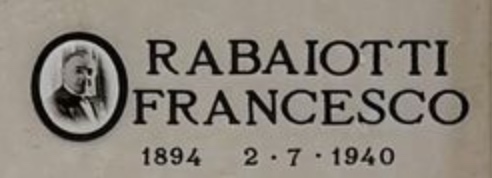
Francesco was born 6 March 1894 at Bardi, Parma and emigrated to Swansea.
His body was recovered from the Mayo coastline and subsequently transferred to Italy
where he was buried in the family plot in the Campo Santo at Bardi.
14. Luigi Tapparo

Luigi was born 22 October 1898 at Bollengo, Torino and emigrated to Edinburgh where
he was employed as a cook at the Royal British Hotel in Edinburgh.
He was buried in Termoncarragh Cemetery, Co. Mayo after his body was recovered.
Luigi was able to be identified as he had a makeshift chain with a disc showing his name
and address.
Luigi's body was taken home to Bollengo for re-burial after the war however
his headstone, paid for by his family, still stands in the cemetery today.
Alongside the headstone there are a number of unmarked graves which most likely contain the
bodies of unidentified Italians recovered at the same time.
Scotland
There was much less Scottish newspaper reporting of Arandora Star casualties. This is primarily
because a fewer number of bodies were recovered. There are only eight known locations around
the coasts of Scotland where casualties have been buried.
- Hallan Cemetery Dalabrog, South Uist
St Barr Old Churchyard, Eoligarry, Barra
St Brendan’s Burial Ground, Barra
- Kilchattan Churchyard, Isle of Colonsay
- Island of Oronsay
- Bowmore New Churchyard, Isle of Islay
- Port Ellen Churchyard, Isle of Islay
- Carleton Bay, South Ayrshire
Details of all the known and identified casualties buried in Scotland are as follows:
1. Francesco D'Inverno

The body of Francesco D’Inverno, born 17 April 1901 at Villa Latina, Frosinone was discovered
on Tuesday, 20 August 1940, by a local inhabitant of Gamesloup, South Ayrshire. The body, wearing
a life-jacket and washed up on the beach was later identified as Francesco D'Inverno from London.
His was the only body to be found on the coastline of mainland Scotland - the others had
been driven by the prevailing winds to the shorelines of the Western Isles.
It is not certain how the body was identified but Francesco is one of the very few victims to have
his death formally recorded in the UK death registers. A death certificate was issued on 9 October
1940 following information made available by the local Procurator Fiscal.
Further information on Francesco is available
here .
The temporary cross erected to mark his grave in 2023 was replaced by this engraved stone in April 2024
2. Giuseppe Delgrosso

Giuseppe was born 20 April 1889 at Borgo Val di Taro (Borgotaro), Parma and emigrated to
Glasgow where he had an Ice Cream Parlour.
His body was discovered at “Prior’s Leap”, Lower Kilchattan, Colonsay and was
initially buried at Leum a' Brhrair on the Isle of Colonsay. After the war, his family arranged
to have his remains moved to St Kentigern’s RC Cemetery, Glasgow.
Today, a cairn marks the spot where Giuseppe was first laid to rest, close to where his body was
recovered, together with this memorial plaque on the cliffs nearby.
The inscription in Gaelic reads:
'I will hide myself under the shadow of thy wing'. Photo courtesy of Alan Davis.
3. Oreste Fisanotti
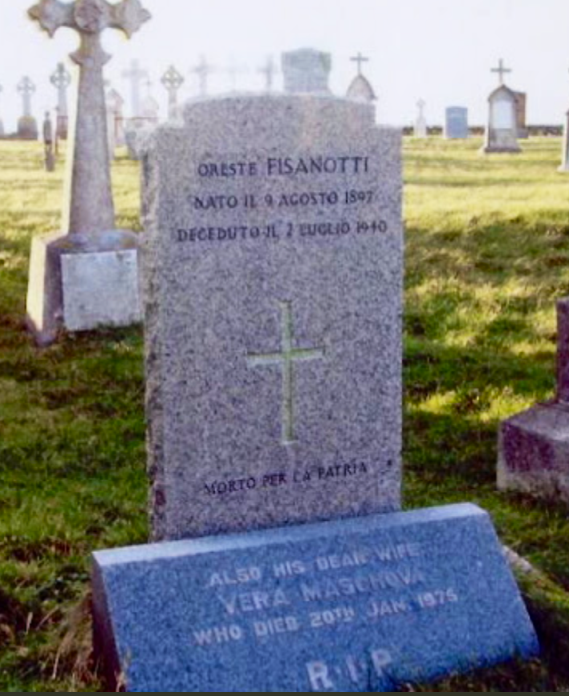
Oreste was born 9 August 1897 at the small town of Mathi, Torino and emigrated to London
where he was a waiter at a London hotel.
He is buried in St Brendan's Catholic Burial Ground, Borve, Isle of Barra.
In London he met and married his wife Vera Maschova -
herself a Russian Revolution refugee from Petrograd.
An additional headstone indicates that
Vera, who died on 20 January 1975, is buried in the same grave.
4. Andrea Gazzi
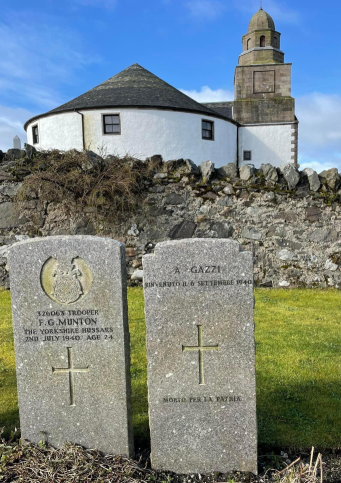
Andrea was born 2 August 1900 at Bardi, Parma and emigrated to Gorseinon, South Wales
where he ran a Fish and Chip Shop.
He was buried in Bowmore New Parish Churchyard, Isle of Islay.
A simple
headstone indicates that he was found on 6 September 1940 and is inscribed MORTO PER LA
PATRIA.
Buried alongside Andrea is Trooper Frank Geoffrey Munton (aged 24) who also lost his life in the disaster. He was one of the Army guards on the Arandora Star. Photo kindly provided by Gerard Ino Opel.
5. Enrico Muzio
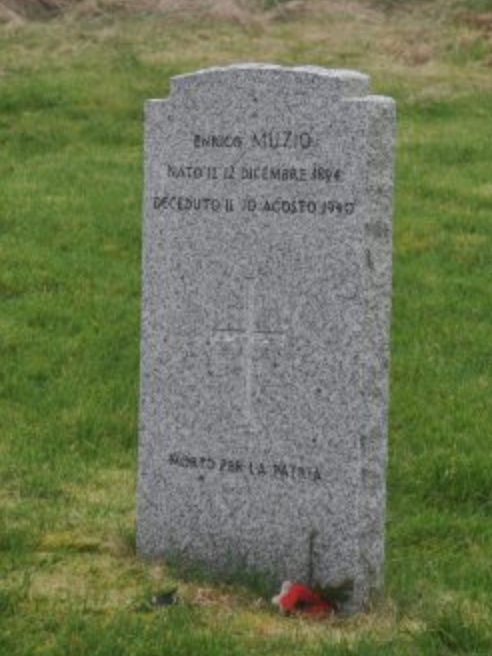
Enrico was born 12 December 1892 at Napoli and emigrated to London.
His body was washed ashore in August 1940 on
the beach behind the home of Compton Mackenzie in Barra. Mackenzie wrote in his diary
"The corpse was identified by his card which showed he had been a tenor, singing probably at
the Teatro San Carlo in Napoli and over here for the BBC and at the Coliseum".
Enrico is buried in St Barr Old Churchyard, Eolgarry, Isle of Barra.
Enrico worked in the UK throughout the 1920s and 1930s, appearing in productions in most
music hall venues. He received acclaim for his singing with references to ‘the brilliant tenor’,
‘the renowned tenor’ and praised for his ability to ‘sing equally well in English,
French and Spanish’ – and, one assumes, also in Italian.
6. Baldassare Plescia
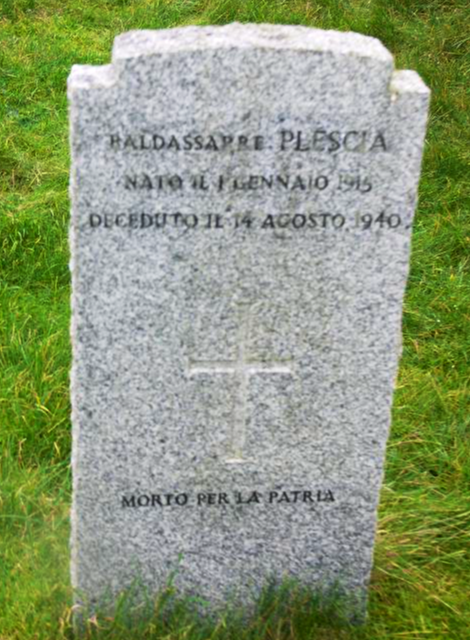
Baldassare Plescia was born 1 January 1915 at Palermo, Sicily and emigrated to London, where he
worked as an Estate Agent's Clerk.
His body was buried in the Cladh Hallan Cemetery, Dalabrog, at the southern end of the Island
of South Uist.
Baldassare's elder brother, Andrea, also perished on the Arandora Star.
7. Vilfrido Sagramati
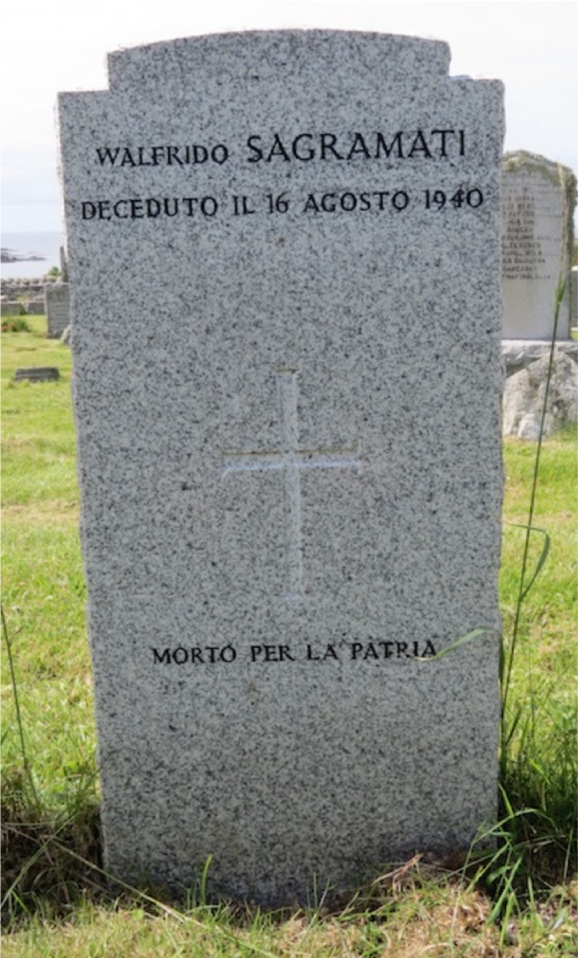
Vilfrido was born 19 October 1910 at Rome and he was enumerated in the 1939 Register
living at 3 Earlham Street, Holborn, London. His employment is given as
none - independent means.
BT334 records his employment status as student.
His body was washed ashore on the Isle of Colonsay in the middle of August 1940.
Vilfrido was initially buried in Kilchattan Old Churchyard on the island.
After the war his family discovered where he lay and arranged to take his remains back home to Italy.
8. Edmondo Armando Sottocornola
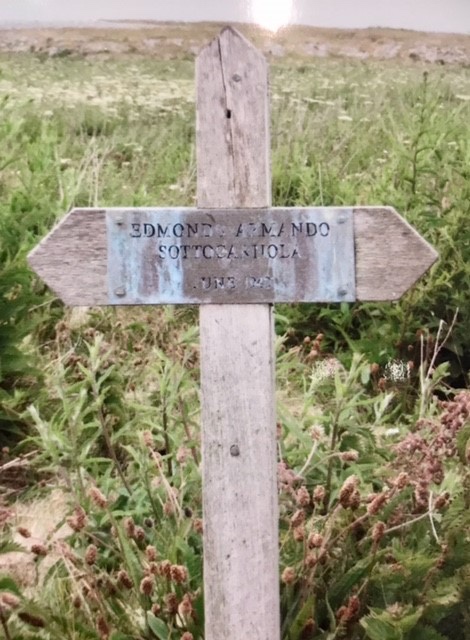
Edmondo was born 2 April 1897 at Gargallo, Novara and he emigrated
to London where he was employed as Head Waiter at the Criterion Restaurant, Piccadilly Circus.
His body was
discovered, 11 August 1940, on the shores of uninhabited island of Eilean nan Ròn.
This tiny island, (Gaelic for 'Island of the Seals'), lies to the south west of the Isle of Oronsay.
Edmondo was buried on the island the following day.
Initially the authorities did consider exhumation and reburial (see Official Scottish Documents
below), however this did not happen due to
the difficulties involved in getting to and landing on the islet itself.
A simple inscribed wooden cross was erected at the site:
"The resting-place of Edmondo Armando
Sottocornola, born 2 April 1897, a native of Gargallo; he was lost in the tragedy
of 'Arandora Star' July 1940".
The original wooden cross marking his grave was replaced with this one by islanders in October 2002.
(Photo courtesy of Alan Davis).
There are plans to replace the wooden cross with a more permanent memorial such as an
inscribed stone.
'Sconosciuto Italiano'
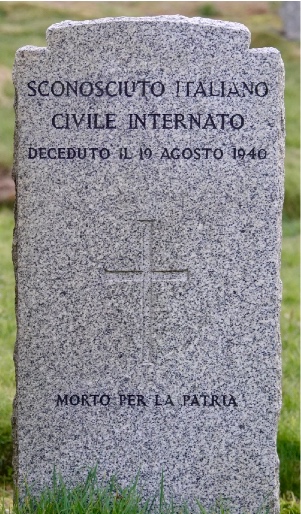
The grave of an unknown Italian is marked by a simple headstone
in the Kilnaughton Old Churchyard, two miles west of Port Ellen on the Isle of Islay.
From the Commonwealth War Graves Commission:
"This churchyard contains five burials of the 1914-1918 War and seven of the 1939-1945 War.
This last total is made up by one sailor, two airmen, and three unidentified Merchant Navy seamen belonging to the United Kingdom, and one unidentified Italian internee".
Extracts from Official Scottish Documents
The following information has been extracted from a photocopy of the typed original documents.
REFERENCE LIST OF BODIES WASHED ASHORE ( on Colonsay) IN ARGYLL, AND BURIED IN:
Kilchattan Old Churchyard, Colonsay Island, Argyll, Oronsay Priory Burial Ground, Oronsay Island, Colonsay & Oronsay, Eilean-nan-Ron (Isle of
Seals), Colonsay and Oronsay (OFF ORONSAY ISLE) (Cragaig Burial Ground, Ulva Island,
Kilninian & Kilmore, Mull.
“Colonsay No. 1” body:- “Eilean-nan-Ron”, (”Isle of Seals”) Isle shore grave, Colonsay & Oronsay.
Ormando SOTTOCORNOLA
Italian Internee, Buried 12.8.40. Doctor states:- “Several months in water”.* Found on Island of
Eilean-nan-Ron, off South West coast of Oronsay Island 11.8.40, on part of Oronsay Island farm.
Parish of Colonsay and Oronsay. Head Waiter, Criterion Restaurant, Piccadilly Circus, London
W.1.
Grave not a recognised burial place and, Island being uninhabited, it is recommended for
exhumation and re-interment elsewhere, either privately, or in the Service Plot in Kilchattan Old
Churchyard, in the neighbouring Island of Colonsay.
*Probably drowned 2.7.40 on S.S. “Arandora Star.”
“Colonsay No. 2” body:- Kilchattan Old Churchyard, Colonsay, Argyll.
UNKNOWN SEAMAN, Merchant Navy. Found at Ardskenish Bay, Colonsay Island, 11.8.40.
Buried 13.8.40. Grave No. “Col/2” Wore heavy blue tweed trousers. Might have been a civilian?
Doctor states:- “Certainly over 2 months in water”.
“Colonsay No. 3” body:- Glasgow (St. Kentigern’s R.C. Cemetery).
Giuseppe DELGROSSO
No. 14700, Italian Internee. Found at “Prior’s Leap”, Lower Kilchattan, Colonsay, on 16.8.40.
Buried on shore 17.8.40 [Local tradition is that he was at first buried nearby, where a cairn now
stands]. Later exhumed and re- interred in St. Kentigern’s R.C. Cemetery, Glasgow in lair No. 37,
Section 10. (P.P.M. erected). Doctor states:- “Must have been in water at least two months”.
“Colonsay No.4” body:- Kilchattan Old Churchayard, Colonsay, Argyll.
Wilfred SAGRAMATI
(7293? Or 58305?), Italian Internee.
Found at Machrins Bay, Colonsay, 16.8.40. Buried 17.8.40. From Warth Mills Interment Camp,
Bury. Doctor states:- “Body in sea at least one month”. Might be “Arandora Star”, sunk 2.7.40?
“Colonsay No. 5” body:- In same grave as No. 4 body (SAGRAMATI)
UNKNOWN INTERNEE, found at “Port Mhor”, Colonsay, 18.8.40. Buried 19.8.40. Doctor
states:- “In water at least a month or 6 weeks.” Probably “Arandora Star”, sunk 2.7.40.
“Colonsay No. 6” body:- In same grave as Nos. 4 and 5 bodies, “Col/4-5-6”.
UNKNOWN SEAMAN. Merchant Navy. Found at Kiloran Bay, Colonsay, 19.8.40. Buried
21.8.40. Doctor states:- “In water at least 6 weeks or 2 months”. Might be “Arandora Star”
“Colonsay No. 7” body:- Kilchattan Old Churchyard, Colonsay, Argyll.
Able Seaman James KELLACHER, R.N.V.R., H.M.S. “Enterprise”.
Found east of Kiloran Bay, Colonsay, 19.8.40. Buried 22.8.40. Grave No. “Col/7”. Of 18.A. Great
King Street, Edinburgh. Doctor states:- “Not more than 2 or 3 weeks in water”.
“Colonsay No. 8” body:- Kilchattan Old Churchyard, Colonsay, Argyll.
UNKNOWN SAILOR, Petty Officer, R.N. (R.C. Religion) Grave No. “Col/8”. Found Kiloran Bay,
Colonsay, 19.8.40. Buried 22.8.40. Doctor states:- In Naval dress. Probably a Petty Officer. Body
badly decomposed.”
“Colonsay No. 9” body:- Kilchattan Old Churchyard, Colonsay, Argyll.
Leading Steward James McINTOSH, H.M.S. “Transylvania”. Found at “Port-na-Fleuchin”,
Uragaig, Colonsay, 20.8.40. Buried 23.8.40, Grave No. “Col/9”. Of 39, Cowdernill Circus,
Knightswood, Glasgow. Doctor states:- “Body badly disfigured”.
“Colonsay No. 10” body:- Kilchattan Old Churchyard, Colonsay, Argyll.
UNKNOWN SEAMAN (“J.H.”), Merchant Navy. H.M.S. “Transylvania”. Found at Inver,
Kilchattan, Colonsay, 20.8.40. Buried 23.8.40. Frave No. “Col/10”. Doctor states: “In water 6
weeks to 2 months.”
“Colonsay No. 11” body:- Kilchattan Old Churchyard, Colonsay, Argyll.
Chief Petty Officer Frederick NORTHGATE, R.N. Found at Inver, Ardalanish Point, Machrins,
Colonsay, 20.8.40. Buried 23.8.40. Grave No. “Col/11”. Usual residence:- 4, Malpas Road,
Dagenham. Doctor states:- “In water for at least six weeks”.
“Colonsay No. 12” body:- Kilchattan Old Churchyard, Colonsay, Argyll.
UNKNOWN SAILOR (Petty Officer) R.N. Found at Dungallon, Colonsay, 20.8.40. Buried
23.8.40. Grave No. “Col/12”. Two Naval collars in pocket; one with name “J. Phinn”, other with
name “G. Tinglay”. Doctor states:- “In water a month to 6 weeks”.
“Colonsay No. 13” body:- Kilchattan Old Churchyard, Colonsay, Argyll.
Stoker Petty Officer Robert STEWART, (MM 31,) R.N.R. (Religion – R.C.)
Sources
- Alan Davis
- Dr. Terri Colpi
- YouTube video: Arandora Star - Ireland’s Legacy
- Donegal Vindicator
- Donegal Democrat
- Stornoway Gazette
- ‘Men that came in with the sea’ by Michael Kennedy (difp@iol.ie)
- Colonsayhistory.info
- Clyde Maritime - The Loss of the Arandora Star
- Imperial War Museums - Islands of Barra and Vatersay
- Ayrshire Advertiser
Download a copy of this article (March 2024) here ===>
Italian Burial Sites: download
Download a copy of the Arandora Star Burials Spreadsheet (2024) here ===>
AS Burial Spreadsheet: download